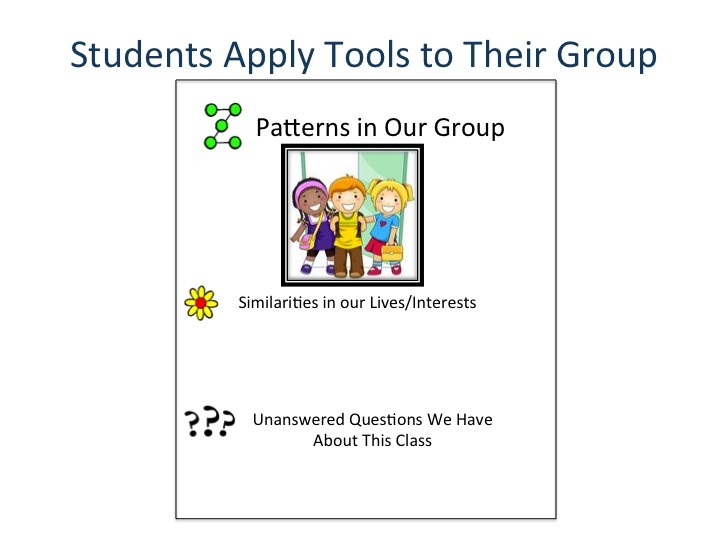
Prompts of Depth and Complexity and Content Imperatives
The critical thinking tools introduced here were developed by Dr. Sandra Kaplan, USC under the auspices of OERI, Javits Curriculum Project T.W.O., 1996. Ideas presented here are also adapted from Flip Book, Too Dr. Sandra Kaplan and Bette Gould
The Depth and Complexity Icons are visual prompts designed to help students go beyond surface level understanding of a concept and enhance their ability to think critically. These critical thinking tools help students dig deeper into a concept (depth) and understand that concept with greater complexity.
In fact, to truly understand something, one must be able to speak the language specific to that topic. One cannot have a critical understanding of that same topic without knowing the details, rules and patterns associated with it or understanding how it may have changed and the varied perspectives through which it is viewed.
Good for All Grades?
Absolutely! I’ve had folks express concerns that the Depth and Complexity icons might be too difficult for young students, but I’ve even worked with kindergarteners using these tools and they pick them up with great ease. See “Introducing Patterns…” below.
Teaching Depth and Complexity Icons
When teaching each prompt, the first thing to do is define the meaning of the icon. Be careful to point out the design itself and how it reveals the meaning. Once the meaning has been defined, link it to prior knowlege. For example, you might ask students to identify where they have seen patterns before. The next step is to have students apply the icons to new learning. This is may be in a text they are reading, piece of art they are analyzing, etc. The final step is to have students apply to real world– current events, new content, etc.
Introduce Yourself with The Icons
It’s the beginning of the year, and more than anything, students want to know about their teacher. Who is this person standing in front of them? Build community in your classroom and introduce the icons to your students all at the same time.
 Introduce yourself! Frame yourself or create a PowerPoint. Select a few tools with which to tell your students about you.
Introduce yourself! Frame yourself or create a PowerPoint. Select a few tools with which to tell your students about you.
Don’t Want to be Framed?
Apply to a Familiar Object or Event
![]() Even the youngest of students can tell you about birthday parties. Create a large frame and put the topic in the middle. Select the icons to be introduced or practiced. Have students discuss and share out. Some examples:
Even the youngest of students can tell you about birthday parties. Create a large frame and put the topic in the middle. Select the icons to be introduced or practiced. Have students discuss and share out. Some examples:
- Specialized language used at birthday parites
- Rules for birthday parties
- Different perspectives on birthday parties
- How birthday parties have changed during their lives
Introduce the prompts of Depth and Complexity through a familiar story.
![]()
Introducing Depth and Complexity using Goldilocks or other familiar story.
Introducing Patterns Along with the Idea of Visual Prompts
Display a pattern for students (see example at right). Have them look at it closely at the details to determine what they see. Ask: What is it called when we have something that repeats over and over again?
What comes next? How do you know?

Most students should be able to tell you that they see a pattern, and they should be able to tell you what comes next in the sequence. Ask: Do you think that by seeing a pattern it helps you predict?
Tell students that they will be using patterns to help them better understand the story (or math, social science, etc.)

Use this walk sign when teaching students to use Depth and Complexity.
Show picture. This is a sign you may have seen before.
Who can tell me what this sign means?
Does it say “It’s safe to walk”?
Or does it just show us a picture that means “It’s safe to walk”?
How do you know what it means? [can show additional pictures)
Sometimes we use special pictures like this to represent something. When we want to look at patterns, we have a special sign we use. It looks like this- Show pattern icon.
 I want you to think… Why do we use this picture to mean patterns?
I want you to think… Why do we use this picture to mean patterns?
If students don’t get it right away, help them see the pattern embedded in the icon.
Circle, line, circle, line, circle, line, etc.
Scholars, I want you to look for/listen etc a pattern as I read you this story (or they read the story).
Opportunities to Practice
 Using the same tools you used to introduce yourself:
Using the same tools you used to introduce yourself:
- Have students frame and themselves or a buddy. Frames can be used to make class introductions.
- Students can work in groups to create a poster or other product to introduce themselves. Students can identify patterns among their group.
This is a great beginning of the year ice-breaker and community building activity to do with your students.
Other Ways to Practice Depth and Compelxity
Students identify theme in a piece of text

Identify prompts in a song

Identify in a short video clip

Check out these examples-
